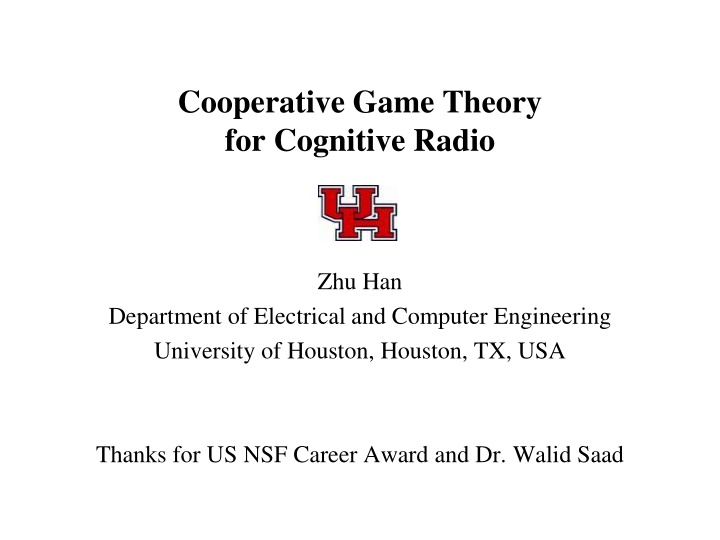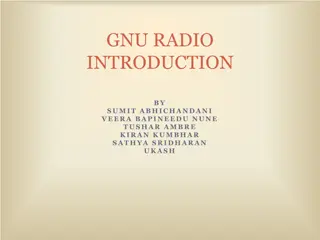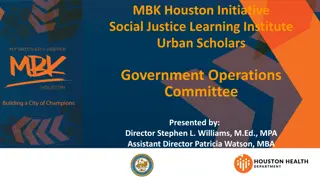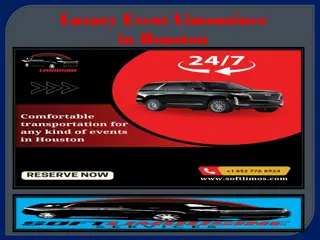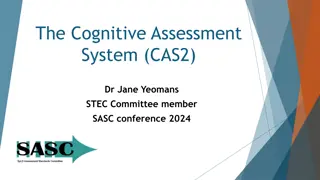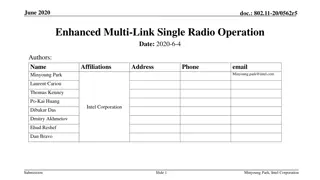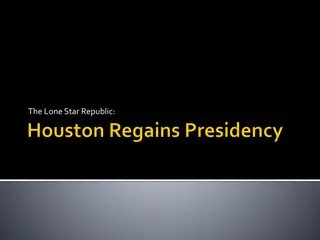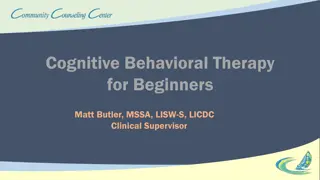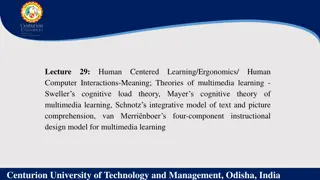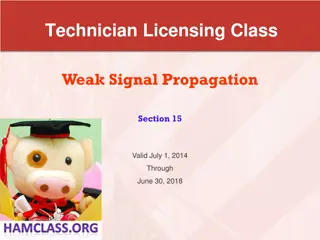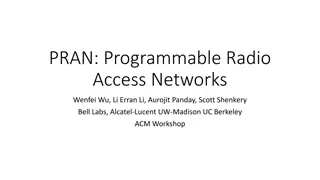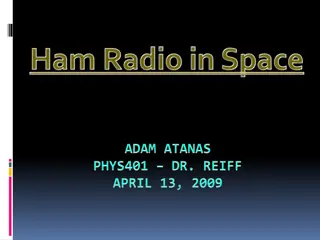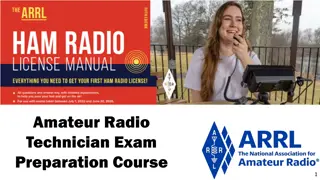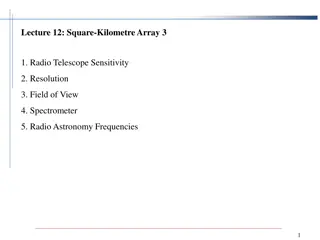Cognitive Radio Network and Game Theory Exploration at University of Houston
Explore the application of cooperative game theory in cognitive radio networks, focusing on spectrum sensing, dynamic spectrum access, and coalitional games. Detailed overview of research conducted at the Department of Electrical and Computer Engineering, University of Houston. Learn about cognitive radio technology, block diagram, spectrum sensing challenges, and collaborative spectrum sensing approaches. Dive into the world of cognitive radio and game theory in wireless communications.
Download Presentation

Please find below an Image/Link to download the presentation.
The content on the website is provided AS IS for your information and personal use only. It may not be sold, licensed, or shared on other websites without obtaining consent from the author.If you encounter any issues during the download, it is possible that the publisher has removed the file from their server.
You are allowed to download the files provided on this website for personal or commercial use, subject to the condition that they are used lawfully. All files are the property of their respective owners.
The content on the website is provided AS IS for your information and personal use only. It may not be sold, licensed, or shared on other websites without obtaining consent from the author.
E N D
Presentation Transcript
Cooperative Game Theory for Cognitive Radio http://tbn0.google.com/images?q=tbn:HMEGXKmAqkMYXM:http://content.answers.com/main/content/wp/en/e/ec/University_of_Houston_Logo.jpg Zhu Han Department of Electrical and Computer Engineering University of Houston, Houston, TX, USA Thanks for US NSF Career Award and Dr. Walid Saad
Outline Cognitive Radio Networks Spectrum Sensing Dynamic Spectrum Access Exploration and Exploitation Overview of Game Theory Coalitional Games Class I: Canonical Coalitional Games Class II: Coalition Formation Games Class III: Coalition Graph Games Conclusions Quick View of Our Research Lab http://tbn0.google.com/images?q=tbn:HMEGXKmAqkMYXM:http://content.answers.com/main/content/wp/en/e/ec/University_of_Houston_Logo.jpg
Cognitive Radio Overview Lane: spectrum Car: mobile user Lane seldom used but reserved for Licensed Spectrum Or Primary Users Public Traffic Lane congested for Unlicensed Spectrum Or Secondary Users http://tbn0.google.com/images?q=tbn:HMEGXKmAqkMYXM:http://content.answers.com/main/content/wp/en/e/ec/University_of_Houston_Logo.jpg
Cognitive Radio Block Diagram A cognitive radio is a radio that is able to sense, adapt and learn from its operating environment 3 Learning/ Decision making knowledge extraction 2 Learn 4 Channel estimation Wireless transmitter 1 Perceive Control Wireless receiver Channel 1 2 Noisy channel information 3 4 Knowledge of transmission environment Noise-removed channel status Decision on transmission parameters http://tbn0.google.com/images?q=tbn:HMEGXKmAqkMYXM:http://content.answers.com/main/content/wp/en/e/ec/University_of_Houston_Logo.jpg
Problem 1: Spectrum Sensing Secondary users must sense the spectrum to Detect the presence of the primary user for reducing interference on primary user Detect spectrum holes to be used for dynamic spectrum access Spectrum sensing is to make a decision between two hypotheses The primary user is present, hypothesis H1 The primary user is absent, hypothesis H0 Channel gain Possible approaches Matched Filter Detectors Energy Detectors Cyclostationary Detectors Noise Primary User Signal http://tbn0.google.com/images?q=tbn:HMEGXKmAqkMYXM:http://content.answers.com/main/content/wp/en/e/ec/University_of_Houston_Logo.jpg
Collaborative Spectrum Sensing Overcome hidden terminal problem Multiple cognitive radio observe together 3- Fusion Center makes final decision: PU present or not 2- the SUs send their Local Sensing bits to a common fusion center 1- the SUs perform Local Sensing of PU signal http://tbn0.google.com/images?q=tbn:HMEGXKmAqkMYXM:http://content.answers.com/main/content/wp/en/e/ec/University_of_Houston_Logo.jpg
Problem 2: Dynamic Spectrum Access Adjust spectrum resource usage in the near-real-time manner in response to changes in the users objectives, changes of radio states, and changes in the environment and external constraints. http://tbn0.google.com/images?q=tbn:HMEGXKmAqkMYXM:http://content.answers.com/main/content/wp/en/e/ec/University_of_Houston_Logo.jpg
Dynamic Spectrum Access (DSA) Dynamic spectrum access allows different wireless users and different types of services to utilize radio spectrum Spectrum Access Model Shared-use of primary licensed spectrum Command and control Exclusive-use Commons-use Long-term exclusive-use Dynamic exclusive-use Spectrum overlay Spectrum underlay http://tbn0.google.com/images?q=tbn:HMEGXKmAqkMYXM:http://content.answers.com/main/content/wp/en/e/ec/University_of_Houston_Logo.jpg
Problem 3: Exploration and Exploitation Exploitation: the immediate benefit gained from accessing the channel with the estimated highest reward Exploration is the process by which the cognitive users tend to probe more channels to discover better channel opportunities. Example: should find new topics or study the current topics http://tbn0.google.com/images?q=tbn:HMEGXKmAqkMYXM:http://content.answers.com/main/content/wp/en/e/ec/University_of_Houston_Logo.jpg
Game Theory Overview What is game theory? The formal study of conflict or cooperation Modeling mutual interaction among rational decision makers Widely used in economics Components of a game Rational players with conflicting interests or mutual benefit Strategies or actions Utility as a payoff of player s and other players actions Outcome: Nash Equilibrium Many types Non-cooperative game theory Cooperative game theory Dynamic game theory Stochastic game Auction theory http://tbn0.google.com/images?q=tbn:HMEGXKmAqkMYXM:http://content.answers.com/main/content/wp/en/e/ec/University_of_Houston_Logo.jpg
Rich Game Theoretical Approaches Non-cooperative static game: play once Prisoner Dilemma Payoff: (user1, user2) Mandayam and Goodman (2001) Virginia tech Repeated game: play multiple times Threat of punishment by repeated game. MAD: Nobel prize 2005. Tit-for-Tat (infocom 2003): Dynamic game: (Basar s book) ODE for state Optimization utility over time HJB and dynamic programming Evolutional game (Hossain and Dusit s work) Stochastic game(Altman s work) http://tbn0.google.com/images?q=tbn:HMEGXKmAqkMYXM:http://content.answers.com/main/content/wp/en/e/ec/University_of_Houston_Logo.jpg
Auction Theory Book of Myerson (Nobel Prize 2007), J. Huang, H. Zheng, X. Li http://tbn0.google.com/images?q=tbn:HMEGXKmAqkMYXM:http://content.answers.com/main/content/wp/en/e/ec/University_of_Houston_Logo.jpg
Cooperative Game Theory Players have mutual benefit to cooperate Startup company: everybody wants IPO, while competing for more stock shares. Coalition in Parlement Namely two types Nash bargaining problems Coalitional game We will focus on coalitional game theory Definition and key concepts New classification Applications in wireless networks Walid Saad, Zhu Han, Merouane Debbah, Are Hjorungnes, and Tamer Basar, ``Coalitional Game Theory for Communication Networks", IEEE Signal Processing Magazine, Special Issue on Game Theory, p.p. 77-97, September 2009. http://tbn0.google.com/images?q=tbn:HMEGXKmAqkMYXM:http://content.answers.com/main/content/wp/en/e/ec/University_of_Houston_Logo.jpg
Coalitional Games: Preliminaries Definition of a coalitional game (N,v) A set of players N, acoalition S is a group of cooperating players ( subset of N ) Worth (utility) of a coalition v In general, v(S) is a real number that represents the gain resulting from a coalition S in the game (N,v) v(N) is the worth of forming the coalition of all users, known as the grand coalition User payoff xi : the portion of v(S) received by a player i in coalition S u u Characteristic form v depends only on the internal structure of the coalition Most common form of coalitional games Partition form v depends only on the whole partition currently in place Hard to solve, still under thorough research in game theory Graph form The value of a coalition depends on a graphstructure that connects the coalition members 14 http://tbn0.google.com/images?q=tbn:HMEGXKmAqkMYXM:http://content.answers.com/main/content/wp/en/e/ec/University_of_Houston_Logo.jpg
Coalitional Games: Utility Transferable utility (TU) The worth v(S) of a coalition S can be distributed arbitrarily among the players in a coalition hence, v(S) is a function from the power set of N over the real line Example: Money, Euro/dollar/RMB Non-transferable utility (NTU) The payoff that a user receives in a coalition is pre-determined, and hence the value of a coalition cannot be described by a function v(S) is a set of payoff vectors that the players in S can achieve Example: channel http://tbn0.google.com/images?q=tbn:HMEGXKmAqkMYXM:http://content.answers.com/main/content/wp/en/e/ec/University_of_Houston_Logo.jpg
Payoff division Equal fair Each user guarantees its non-cooperative utility The extra worth is divided equally among coalition users Proportional fair Each user guarantees its non-cooperative utility A proportional fair division, based on the non-cooperative worth, is done on the extra utility available through cooperation Other fairness Shapley value Nucleolus Market Fairness http://tbn0.google.com/images?q=tbn:HMEGXKmAqkMYXM:http://content.answers.com/main/content/wp/en/e/ec/University_of_Houston_Logo.jpg
An example coalitional game Example of a coalition game: Majority Vote President is elected by majority vote A coalition consisting of a majority of players has a worth of 1 since it is a decision maker Value of a coalition does not depend on the external strategies of the users u This game is in characteristic function form If the voters divide the value as money u Transferable utility http://tbn0.google.com/images?q=tbn:HMEGXKmAqkMYXM:http://content.answers.com/main/content/wp/en/e/ec/University_of_Houston_Logo.jpg
Outline Cognitive Radio Networks Spectrum Sensing Dynamic Spectrum Access Exploration and Exploitation Overview of Game Theory Coalitional Games Class I: Canonical Coalitional Games Class II: Coalition Formation Games Class III: Coalition Graph Games Conclusions Quick View of Our Research Lab http://tbn0.google.com/images?q=tbn:HMEGXKmAqkMYXM:http://content.answers.com/main/content/wp/en/e/ec/University_of_Houston_Logo.jpg
A new classification - Players interactions are governed by a communication graph structure. -Key question How to stabilize the grand coalition or form a network structure taking into account the communication graph? - The network structure that forms depends on gains and costs from cooperation. -Key question How to form an appropriate coalitional structure (topology) and how to study its properties? - Solutions are complex, combine concepts from coalitions, and non- - The grand coalition of all users is an optimal structure. -Key question How to stabilize the grand coalition? - Several well-defined solution concepts exist. - More complex than Class I, with no formal solution concepts. cooperative games http://tbn0.google.com/images?q=tbn:HMEGXKmAqkMYXM:http://content.answers.com/main/content/wp/en/e/ec/University_of_Houston_Logo.jpg
Class I: Canonical Coalitional Games Main properties Cooperation is always beneficial u The grand coalition is guaranteed to form The game is superadditive The most famous type of coalitional games! Main Objectives Study the properties and stability of the grand coalition u How can we stabilize the grand coalition? How to divide the utility and gains in a fair manner? u Improper payoff division => incentive for players to leave coalition http://tbn0.google.com/images?q=tbn:HMEGXKmAqkMYXM:http://content.answers.com/main/content/wp/en/e/ec/University_of_Houston_Logo.jpg
Canonical games: Solution concepts The Core: the most renowned concept For a TU game, the coreis a set of payoff allocation (x1, . . .,xN) satisfying two conditions The core can be empty u A non-empty core in a superadditive game => stable grand coalition The drawbacks of the core The core is often empty. When the core is non-empty it is often a large set. The allocations that lie in the core are often unfair. http://tbn0.google.com/images?q=tbn:HMEGXKmAqkMYXM:http://content.answers.com/main/content/wp/en/e/ec/University_of_Houston_Logo.jpg
Ex: Cooperative Transmission New communication paradigm Exploring broadcast nature of wireless channel Relays can be served as virtual antenna of the source MIMO system Multi-user and multi-route diversity Destination Destination Phase 1 Phase 1 Phase 2 Phase 2 Sender Sender Relay Relay Most popular research in current wireless communication Industrial standard: IEEE WiMAX 802.16J http://tbn0.google.com/images?q=tbn:HMEGXKmAqkMYXM:http://content.answers.com/main/content/wp/en/e/ec/University_of_Houston_Logo.jpg
Cooperative Transmission Model No cooperation (direct transmission), primary user needs power Cooperative transmission Stage one: direct transmission. s, source; r, relay; d, destination Stage two: relay retransmission using orthogonal channels, amplified-and- forward Maximal ration combining at the receiver of backbone node To achieve same SNR, power saving for primary user P0<Pd http://tbn0.google.com/images?q=tbn:HMEGXKmAqkMYXM:http://content.answers.com/main/content/wp/en/e/ec/University_of_Houston_Logo.jpg
Main Idea To get a good position, try to volunteer first CR users PR transmission CR nodes help the PU node reduce transmission power using cooperative transmission, for future rewards of transmission. The idea can be formulated by a coalition game. http://tbn0.google.com/images?q=tbn:HMEGXKmAqkMYXM:http://content.answers.com/main/content/wp/en/e/ec/University_of_Houston_Logo.jpg
Applications of canonical games Rate allocation in a Gaussian multiple access channel (La and Anantharam, 2003) The grand coalition maximizes the channel capacity How to allocate the capacity in a fair way that stabilizes the grand coalition? Mathur et al., group from WINLAB, worked on receivers and ideal transmitters cooperation using canonical games (Asilomar 2006, IEEE JSAC, 2008) Curse of the boundary nodes (packet forwarding application) (Z. Han and V. Poor, IEEE Trans. Comm. 2009) Slepian-Wolf source coding game Any application where The grand coalition forms (no cost for cooperation) Stability and fairness are key issues 25 http://tbn0.google.com/images?q=tbn:HMEGXKmAqkMYXM:http://content.answers.com/main/content/wp/en/e/ec/University_of_Houston_Logo.jpg
Class II: Coalition Formation Games Main Properties The game is NOT superadditive Cooperation gains are limited by a cost u The grand coalition is NOT guaranteed to form Cluster the network into partitions New issues: network topology, coalition formation process, environmental changes, etc Key Questions How can the users form coalitions? What is the network structure that will form? How can the users adapt to environmental changes such as mobility, the deployment of new users, or others? Can we say anything on the stability of the network structure? http://tbn0.google.com/images?q=tbn:HMEGXKmAqkMYXM:http://content.answers.com/main/content/wp/en/e/ec/University_of_Houston_Logo.jpg
Coalition Formation: Merge and Split Merge rule: merge any group of coalitions where Split rule: split any group of coalitions where A decision to merge (split) is an agreement between all players to form (break) a new coalition Socialist (social well fare improved by the decision) Capitalist (individual benefit improved) http://tbn0.google.com/images?q=tbn:HMEGXKmAqkMYXM:http://content.answers.com/main/content/wp/en/e/ec/University_of_Houston_Logo.jpg
Merge and Split: Properties Any merge and split iteration converges and results in a final partition. Merge and split decision Individual decision Coalition decision Can be implemented in a distributed manner with no reliance on any centralized entity Using the Pareto order ensures that no player is worse off through merge or split Other orders or preference relations can be used http://tbn0.google.com/images?q=tbn:HMEGXKmAqkMYXM:http://content.answers.com/main/content/wp/en/e/ec/University_of_Houston_Logo.jpg
Stability Notions Dhp stable No users can defect via merge/split Partition resulting from merge and split is Dhp stable Dc stable No users can defect to form a new collection in N A Dc stable partition is socially optimal When it exists, it is the unique outcome of any merge and split iteration Strongest type of stability http://tbn0.google.com/images?q=tbn:HMEGXKmAqkMYXM:http://content.answers.com/main/content/wp/en/e/ec/University_of_Houston_Logo.jpg
Merge and Split algorithm Initial Network State Merge Self organize network Split After mobility Arbitray iterations until it terminates Dhp stability guaranteed Conditional Dc stability Resulting partition http://tbn0.google.com/images?q=tbn:HMEGXKmAqkMYXM:http://content.answers.com/main/content/wp/en/e/ec/University_of_Houston_Logo.jpg
Distributed Collaborative Sensing Coalition head Distributed collaborative sensing between the users with no centralized fusion center Which groups will form? Coalitional games! http://tbn0.google.com/images?q=tbn:HMEGXKmAqkMYXM:http://content.answers.com/main/content/wp/en/e/ec/University_of_Houston_Logo.jpg
Simulation Results When allowed to make distributed decisions, SU 4 prefers to stay with {2,1,6} http://tbn0.google.com/images?q=tbn:HMEGXKmAqkMYXM:http://content.answers.com/main/content/wp/en/e/ec/University_of_Houston_Logo.jpg
Simulation Results (1) http://tbn0.google.com/images?q=tbn:HMEGXKmAqkMYXM:http://content.answers.com/main/content/wp/en/e/ec/University_of_Houston_Logo.jpg
Simulation Results (2) The gap with the optimal solution in probability of miss performance is compensated by a lower false alarm http://tbn0.google.com/images?q=tbn:HMEGXKmAqkMYXM:http://content.answers.com/main/content/wp/en/e/ec/University_of_Houston_Logo.jpg
Summary of Applications Cd Ce Small cell and femtocell networks Physical layer security Users cooperation Best paper award Wiopt 2009 + ACM MONET 2011 Assignment (JSAC, March 2011) Spectrum leasing (JSAC, March 2011) Interference Alignment and cooperation (TWC, May 2011) Eavesdroppers cooperation and routing (CAMSAP 2009, Gamecomm 2008, MILCOM 2011) Cooperative FAPs, IEEE WCNC 2011 Virtual MIMO IEEE ICC 2008 IEEE TWC, 2009 http://tbn0.google.com/images?q=tbn:HMEGXKmAqkMYXM:http://content.answers.com/main/content/wp/en/e/ec/University_of_Houston_Logo.jpg
Summary of Applications Cognitive radio Spectrum sensing (INFOCOM 2009, IEEE TVT 2011) Secondary BS cooperation (WCNC 2010) Joint sensing and access (submitted March 2011, IEEE JSTSP) Bayesian Nonparametric Learning (submitted to JSAC, Feb 2011) Vehicular networks IEEE TWC, December 2010, IEEE GLOBECOM 10 IEEE JSAC, January 2011 Others: Wireless agents (TMC 2011), Smart Grids, Security risk management , P2P networks (GLOBECOM 2010), More to come 36 http://tbn0.google.com/images?q=tbn:HMEGXKmAqkMYXM:http://content.answers.com/main/content/wp/en/e/ec/University_of_Houston_Logo.jpg
Class III: Coalition Graph Games Main properties The game is in graph form u May depend on externalities also There is a graph that connects the players of every coalition Cooperation with or without cost A Hybrid type of games: concepts from classes I and II, as well as non- cooperative games http://tbn0.google.com/images?q=tbn:HMEGXKmAqkMYXM:http://content.answers.com/main/content/wp/en/e/ec/University_of_Houston_Logo.jpg
Coalition Graph Games First thought of by Myerson, 1977, called Coalitional games with communication structure Axiomatic approach to find a Shapley-like value for a coalitional game with an underlying graph structure Coalition value depends on the graph The dependence is only based on connections Key Questions How can the users form the graph structure that will result in the network? If all players form a single graph (grand coalition with a graph), can it be stabilized? How can the users adapt to environmental changes such as mobility, the deployment of new users, or others? What is the effect of the graph on the game? http://tbn0.google.com/images?q=tbn:HMEGXKmAqkMYXM:http://content.answers.com/main/content/wp/en/e/ec/University_of_Houston_Logo.jpg
Hierarchical Network Formation Multi-hop hierarchical networks LTE and WiMAX 802.16j We consider uplink transmission How to determine the hierarchies? We assume a fixed distance-based hierarchy division Others divisions can be accommodated How to form the tree topology? Network formation games New concept of hierarchial Nash equilibrium Routing in communication networks See the work by Johari (Stanford) Many future possibilities The formation of graphs is ubiquitous in the context of networks http://tbn0.google.com/images?q=tbn:HMEGXKmAqkMYXM:http://content.answers.com/main/content/wp/en/e/ec/University_of_Houston_Logo.jpg
Summary of coalitional game Cognitive radio network and its basic problems Coalitional games are a strong tool for different models in wireless and communication networks A novel classification that can help in identifying potential applications A tool for next generation self-organizing networks Especially through coalition formation and network formation games Try to find collaboration among experts here Try to sell books http://tbn0.google.com/images?q=tbn:HMEGXKmAqkMYXM:http://content.answers.com/main/content/wp/en/e/ec/University_of_Houston_Logo.jpg
Overview of Wireless Amigo Lab Lab Overview 7 Ph.D. students, 2 joint postdocs (with Rice and Princeton) supported by 5 concurrent NSF,1 DoD, and 1 Qatar grants Current Concentration Game theoretical approach for wireless networking Compressive sensing and its application Smartgrid communication Bayesian nonparametric learning Security: trust management, belief network, gossip based Kalman Physical layer security Quickest detection Cognitive radio routing/security Sniffing: femto cell and cloud computing USRP2 Implementation Testbed http://tbn0.google.com/images?q=tbn:HMEGXKmAqkMYXM:http://content.answers.com/main/content/wp/en/e/ec/University_of_Houston_Logo.jpg
Questions? Thank you very much http://tbn0.google.com/images?q=tbn:HMEGXKmAqkMYXM:http://content.answers.com/main/content/wp/en/e/ec/University_of_Houston_Logo.jpg
